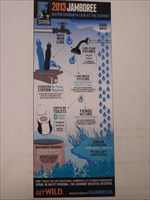1. State what was "taken" from this site "to build America" (according to the sign).
2. Explain geologically how coal was formed in this area of West Virginia.
3.
Describe the ravine you see beneath the bridge in geological terms.
It is not necessary for you to seek outside sources to complete these tasks; all information can be found here, or at the physical site.
Email your answers to me, separately from your log, which you may post right away as a"Find". If there is a problem, or if you have a question, then I will write back to you.
Enjoy continuing to learn about geology in your country and in the world. Plus, please take time to read about academic research that has been done to preserve our geological environment. And think about and share innovative ideas to promote and practice sustainability for our planet Earth.
EARTHCACHE RULES
When participating in EarthCache, you, the geocacher, agree to adhere to the principles of geocaching, Leave No Trace, and Outdoor Ethics. You also agree that the site must not be damaged, and that the fragile ecosystems must be respected. EarthCache visitors collect memories, not samples, from these virtual sites. No physical caches or other items are to be left at the EarthCache site. Learn about your Earth's geology, protect it, and have fun.
GEOLOGY OF SUMMIT BECHTEL RESERVE, WV
West Virginia's New River Gorge canyon cliffs sliced the Appalachian Plateau to reveal 350 million years of geologic history and 3,200 feet of ancient rock formations. Exposed were sandstone, shale, and coal. Formation of the coal originated with dead plants deposited 200 million years ago. Coal is an organic sedimentary rock that formed from accumulated and preserved plant materials. To produce a coal seam, the rate of thick layering of plant debris must accumulate faster than the rate of decay. Once the debris are layered, they must be buried under mud or sand sediments. The weight of the sediments compacts the debris layers until they are transformed into coal. Ten feet of debris are compacted into one foot of coal.
Magnificent exposure of the coal seams led to the first coal mines in West Virginia. When the riverside railroad was completed in 1873, dozens of mining companies opened and led to more than 60 coal towns to support the industry. In tribute to these mining towns glorious in their heyday, the Boy Scouts named the Summit campsites after them: Prince, Thurman, Harvey, Kaymoor, etc. The town of Mount Hope, just outside of the Summit, still displays sights that existed during the 1920s with grand buildings of the area's largest coal enterprise, the New River Company, and other major town existence amongst the vast coal fields. More than 16 million tons of coal had been hacked from 1900 to 1962. An important fossil fuel, coal plus oil and natural gas are the top three.
The predecessor land to the Summit was the 10,600-acre track known as Garden Grounds with its forested mountains and flowing streams adjacent to the 70,000-acre New River Gorge National River.

For example, fringe wetlands bordering the lakes actively treat drainage from roads and campsites, reducing storm-runoff. Waste-water is passively treated in lagoons then used to drip-irrigate local forests, restoring the down-streams.
EarthCaches also celebrate three other high adventure bases:
PHILMONT SCOUT RANCH in New Mexico (GC56VYB)
SUMMIT BECHTEL RESERVE in West Virginia (GC4KE2X)
FLORIDA SEA BASE in Florida (GC6A0NH)
Try to find time to visit these EarthCaches to experience a bit of how high adventure expeditions affect youth and geocachers alike. Outdoor challenges shape youth and teach them about themselves. High adventure EarthCaches unveil geological magnificence and teach you about your Earth. Both activities emphasize the sustainability of our fragile environment.
SOURCES
Coalfields of the Appalachian Mountains: An Encyclopedia of Appalachian Coal Towns.
http://www.coalcampusa.com/
BSA National Jamboree on Deep Green Sustainability.
Geologic Map of the New River Gorge Area, Fayette, Raleigh, and Summers Counties, West Virginia: K.J. Englund and others, 1977, U.S. Geological Survey Open File Report OF-77-76-A.
Beneath the New River Gorge: J.F. Schwietering, in 1984 Mountain State Geology magazine, p. 23-24. Color diagram of the geologic formations underlying the gorge. Accompanying explanatory test. Publication MSG-84*. Also available on-line: WWW version, Beneath the New River Gorge.